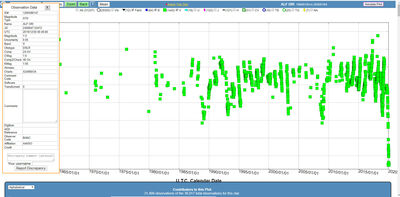I've always enjoyed stargazing and many years ago I even owned and regularly used a nice SCT (Schmidt Cassegrain Telescope). It was a 10" Meade with motorized "goto" feature. Well, unless you are heavy into photography, star and planet observations get old over time, especially when the telescope is 100 lbs, bulky and delicate. I sold it years ago because it just got to be more trouble than it was worth but soon I think I might regret that move in the next 1-2 years and perhaps much sooner.
The reason for this is that astronomers have observed that when a red giant like Betelgeuse suddenly gets dim it can be the calm before the storm. Below is the chart that is driving all of the headlines on this matter and you can see the rapid plunge is just what many have been waiting for.

Well, this has gone dim before and then recovered. Not once but many times as you can see. Now, it was never nearly as dim as right now but still how can I, someone who knows very little about the real science of red giants, have any opinion on this worth considering at all? After all, in this world we see many if not most people flapping their gums about stuff which they know nothing about except perhaps what was in last night's headlines. So why would I even think I had any special insight to offer?
And of course I may turn out to be wrong about this, but at least I have reasons for saying it. And the reason is documented in the chart mark up below. Since after decades of working with them I believe that Elliott waves are somehow built into the fabric of our universe, I think they apply to all charts. If you look at the mark up below I did exactly the same analysis on this chart of Betelgeuse light output over time as I would do on any stock chart. Interestingly this recent collapse has made it all the way back down to the lower rail, a move which was in fact predicted in advance many years ago by the data points near red 1 and red 3. This dimness is now down at support of whatever all the factors are that cause red giants to vary in brightness before they explode. It's akin to the wild gyrations that a spinning plate begins to exhibit just before it falls off the stick.
Time will tell, but these expanding wedges do not plateau down at the low of red 5. They usually put in a very sudden "vee" style bottom and then reverse up faster than any of the other moves that occurred to date in the structure. This is just what we would see if Betelgeuse exploded 600 years ago and the light is about to hit us in 1-2 years. If it can last longer than that then the odds go down rapidly that this is marking the big event. Why? Because that would break the expanding wedge model. These Elliott wave models are not open ended by any means. The chart in question will either perform per the model or it will not. So what we have below is an Elliott wave model setup for explosion. This simply says the odds favor the explosion over the non-explosion possible outcome.
Generally I do not like to see expanding wedges hit the 5th rail. I like to see them fall a bit short before reversing. So I will give this 65-70% chance of exploding. But if it suddenly begins to move up then it could be days, not weeks or years before the explosion. Once an expanding wedge reverses it tends to not dally about.




No comments:
Post a Comment